In artificial conditions, dracaena grows 13 to 15 years. The shoots of some of its species for 6 months are able to stretch to half a meter. The leaves live for about a year, and then dry up and fall off, exposing the lower part of the trunk. Over time, the plant loses its decorativeness, turning into a kind of palm tree. In this regard, many flower owners are interested in how to trim the dracaena for branching.
Material Content:
Principles of formation of dracaena bush
Dracaena offered for sale in specialized stores already have a shaped crown. The task of the grower who bought such a plant is to maintain its decorative appearance by conducting planned pruning.

When propagating dracaena at home, the crown is formed independently, adhering to certain principles:
- The first pruning is carried out when the plant reaches a height of at least 30 cm from the soil level to the point of growth of the upper leaves.
- All manipulations are carried out with a well-sharpened tool and use only clean material. Slices are carried out evenly, without squeezing the tissue. Breaking off parts of the shoot is unacceptable.
- Pruning in order to form a crown is carried out during the period when active vegetation begins and only on a healthy plant.
- The pruning should not be combined with a transplant, it is fraught with the loss of a flower. The minimum interval between these procedures should be at least 2 months.
Best time to prune a plant
Pruning of dracaena is carried out in the spring, in April or May, during the activation of all the vital processes of the plant.
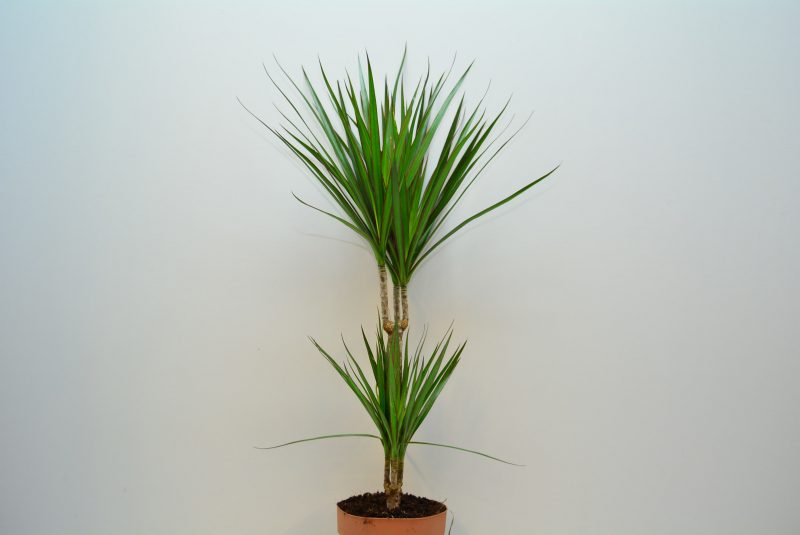
This contributes to faster healing of wounds and the growth of new shoots.
However, there are times when a plant needs emergency pruning. For example, a flower is damaged by pests or a part of the shoot has broken off. In these and similar cases, emergency sanitary pruning is performed. When carrying out it, special attention is paid to the subsequent care of the plant following the pruning.
How to prune dracaena for branching
With independent cultivation of dracaena, it is important to carry out the first pruning on time and correctly, designed to begin the formation of the crown.
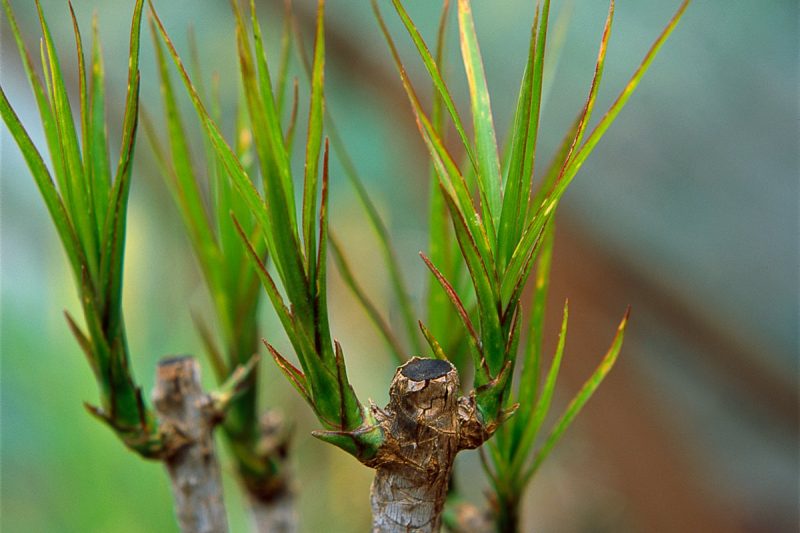
It consists in carrying out several simple actions, as a result of which the tip of the dracaena is removed:
- On the stem of the plant, the location of the cut is indicated, given that young shoots appear below.
- With a quick movement, an even cross section is carried out.
- The resulting juice is dried with a porous material and treated with garden var or paraffin. Shoots of some species of dracaena have leaves below the cut. They are removed, exposing the trunk section of 10 - 15 cm.
- The leafless area below the cut is treated with a solution of a drug that stimulates growth processes, for example, Zircon and is wrapped with wet sphagnum. Moss is fixed on top with any waterproof material. It will not only hold the sphagnum layer, but also help maintain its moisture.
- To create greenhouse conditions, a transparent plastic bag is put on the trimmed part of the shoot, simulating a greenhouse, and the plant itself is placed at air temperatures from 22 to 27 ° C in a slightly darkened place.
Care of the young dracaena after the first pruning, before the appearance of the side shoots, consists in regularly moistening the soil, which is best done from below, through the pallet, and in weekly airing the part of the flower that is closed with the bag.
Lateral kidneys wake up for a rather long time - 2 to 3 months. After swelling and hatching, the moss is removed, leaving an impromptu greenhouse to maintain the microclimate. Of the majority of the formed buds, new shoots will develop, so their number is adjusted according to the plan of the grower.
Trimming for side shoots
When shoots of at least 30 cm long develop from the lateral buds of the dracaena, they are again shortened, stimulating the growth of lateral branches.
Acquired formed plants are subject to a similar procedure.
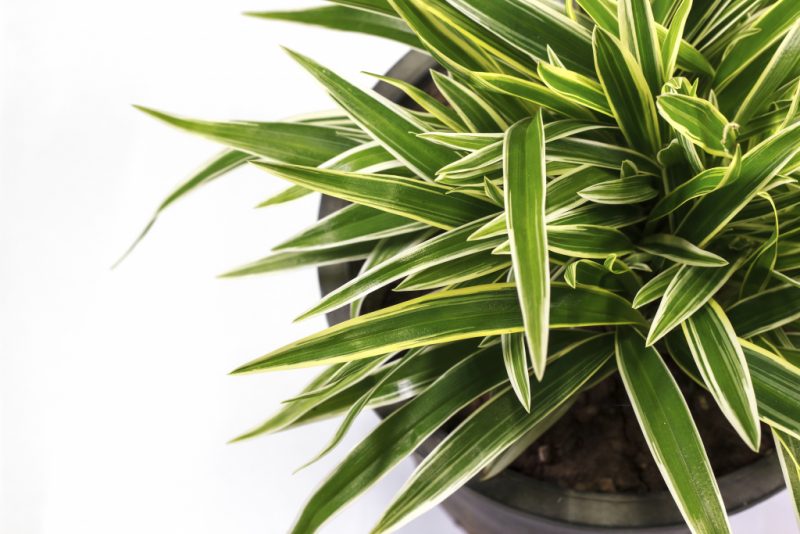
They are formed according to the same principles and rules as the first pruning, additionally taking into account 2 factors:
- Lateral shoots are cut at different (from 15 to 30 cm) heights from the main stem. This will form a larger crown.
- The harmonious development of shoots is possible only if they are evenly lit, so the plant is periodically rotated around its axis.
Home pruning rules
Pruning of dracaena is carried out not only in order to form a crown, but also for harvesting cuttings used for vegetative propagation of a flower.
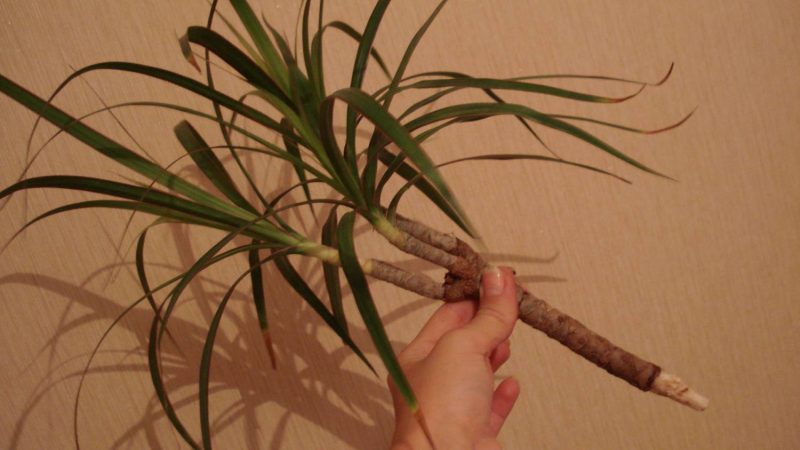
- As apical cuttings, the tops of shoots ending in leaf rosettes with a length of 15 to 30 cm are used.
- Stem cuttings, or chubuki, are cut from elongated and, as a rule, bare parts of shoots 7-10 cm long.
Pruning in order to obtain cuttings is carried out in the spring, following the principles and technology of forming pruning.
Dracaena care after pruning
A month after pruning, the side shoots are sufficiently strong. The greenhouse can be removed and the flower moved to a permanent place. Care for dracaena after pruning consists of timely regular watering, spraying the shoots and top dressing.
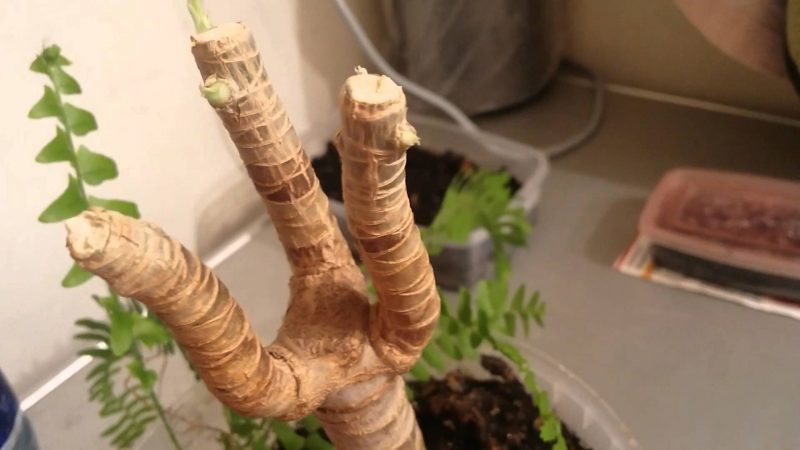
- After pruning, the plant is sensitive to a lack of moisture and waterlogging, so it is important to observe the correct irrigation regime, which does not allow complete drying of the earthen coma and stagnation of water in the pan.
- Dracaena gratefully responds to the irrigation of leaves and shoots with water, which is carried out in order to increase air humidity, as a hygienic procedure and as foliar dressing, irrigating the shoots with water once a week with the addition of mineral additives and drugs that stimulate shoot growth.
- After the formation of the crown, the plant grows actively, requiring an increased amount of nutrients, so it will be appropriate to conduct root dressing, involving the alternation of the use of mineral and organic fertilizers. In summer, they are brought in once every 2 weeks, in winter 1 time per month is enough.
Proper and timely dracaena pruning, as well as good follow-up care, will allow you to get a plant with a lush decorative crown, which for many years will delight others with its beauty.












